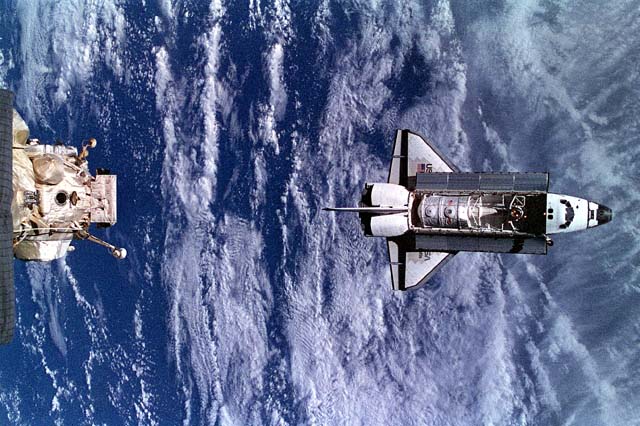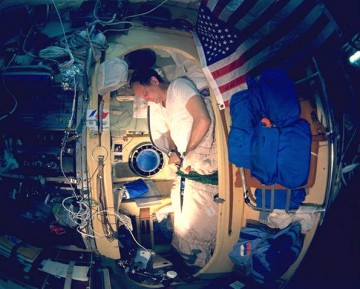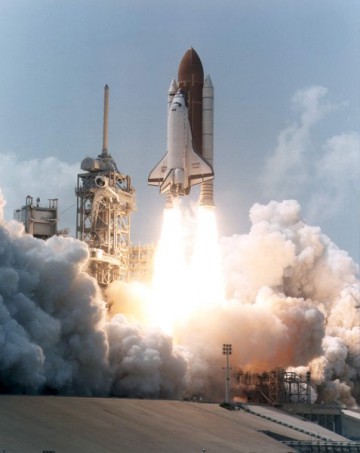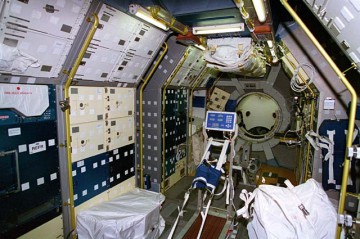
The coming days and weeks mark a pair of significant anniversaries in the history of co-operation between the United States and Russia. In mid-July, 40 years will have passed since the Apollo-Soyuz Test Project (ASTP)—when U.S. astronauts Tom Stafford, Vance Brand, and Deke Slayton worked together in orbit for a few days with Soviet cosmonauts Alexei Leonov and Valeri Kubasov—and, next week, on 27 June, NASA will remember 20 years since the first docking mission between the Space Shuttle and the Mir space station. As part of a wide-ranging effort to bring the two former foes together in the International Space Station (ISS) partnership, and to expose U.S. astronauts to long-duration flights for the first time since Skylab, the first Shuttle-Mir mission was one of the most significant space missions of the 1990s.
As described in yesterday’s AmericaSpace article, Shuttle-Mir arose in the midst and immediate aftermath of the fall of the Soviet Union, as the respective administrations of George H.W. Bush and Bill Clinton sought to draw Russia into the international partnership and restrict the possibility of haemorrhaging technology to undesirable locations, such as Iran. Following a series of high-level summits and talks between 1991-1993, two cosmonauts—Sergei Krikalev and Vladimir Titov—flew aboard shuttle missions STS-60 in February 1994 and STS-63 in February 1995, the latter of which achieved a close-range flyby of Mir. This was followed by the long-duration voyage of U.S. astronaut Norm Thagard, who launched to Mir aboard Soyuz TM-18 in March 1995, although his extensive program of scientific research was severely impaired by the delayed arrival of Russia’s Spektr module, which contained most of his equipment. Finally, in early June, Spektr arrived at Mir, to be followed, at the month’s end, by Space Shuttle Atlantis herself.
In addition to bringing Thagard and his Russian crewmates, Vladimir Dezhurov and Gennadi Strekalov, back to Earth, STS-71 was also tasked with delivering their replacements, cosmonauts Anatoli Solovyov and Nikolai Budarin, alongside the “core” shuttle crew of Commander Robert “Hoot” Gibson, Pilot Charlie Precourt, and Mission Specialists Ellen Baker, Greg Harbaugh, and Bonnie Dunbar. As a consequence, for the first time in the shuttle era, Atlantis would launch with seven crew members and return with eight. Although a crew of eight had flown on Mission 61A in the fall of 1985, STS-71 would mark the first occasion on which a shuttle had returned from orbit with different members and with a larger number than that which it had launched.

It was a situation which made NASA and the Russians particularly anxious. NASA Associate Administrator for Russia, former astronaut Guy Gardner, had recommended using STS-71 as a crew-exchange flight, but the Russians felt that this might interfere with training plans. At length, in June 1994, the crews were named. Gibson, who had earlier served as NASA’s Chief Astronaut, seemed the obvious choice to command STS-71, but the original candidate was Steve Nagel, whose name was said to have been rejected at high-level by George W.S. Abbey, then the powerful deputy director of the Johnson Space Center (JSC) in Houston, Texas. Nagel—who died last year—said little of the assignment in his NASA Oral History, but his disappointment was obvious. “I was vying for another flight and my name had been submitted for STS-71, but that wasn’t going anywhere,” he explained. “I wasn’t going to get on that flight.” He left the Astronaut Office in March 1995.
Pure serendipity led to STS-71 becoming America’s 100th human space mission since the inaugural voyage of Al Shepard in May 1961. Originally scheduled for late May 1995, ahead of the STS-70 mission, delays to the launch of the Spektr module and the need for additional on-orbit checkout time pushed STS-71 until late June. NASA and Russian managers settled on a five-day block between 19-24 June to launch Atlantis, and, according to the pre-flight press kit, the final date was the 23rd, within a tight “window” of 5-10 minutes to create the optimum conditions to reach Mir on the third day of the 10-day mission.
Unfortunately, it became clear that the unpredictable Florida weather simply would not co-operate on 23 June and the launch was scrubbed, ahead of fueling the External Tank (ET), due to severe weather and lightning strikes a mere 8 miles (5 km) from the pad. Heavy cloud cover and thunderstorms put paid to a second attempt on the 24th—much to Gennadi Strekalov’s annoyance, watching from Mir—and the launch was rescheduled for 3:32 p.m. EDT on the 27th, at the opening of a carefully-timed window, which extended for 10 minutes and 19 seconds.
With only a 60 percent chance of acceptable weather for the third launch attempt, the seven-member crew suited-up in their orange pressure suits and departed the Operations & Checkout (O&C) Building at the Kennedy Space Center (KSC) at 11:20 a.m., arriving at the base of Pad 39A about 15 minutes later. The situation weather steadily improved, however, and the skies cleared to permit a spectacular, on-time liftoff of STS-71. Nine minutes later, Atlantis was inserted into an orbit with an apogee of 181 miles (292 km) and a perigee of 97.5 miles (157 km), “the lowest altitude ever flown by a Space Shuttle,” according to NASA, which allowed her to close the 8,050-mile (12,960-km) distance to Mir at an initial rate of about 1,010 miles (1,630 km) with each 90-minute circuit of Earth. A little under four hours into the mission, Gibson and Precourt fired Atlantis’ twin Orbital Maneuvering System (OMS) engines for two minutes in the so-called “NC-1” burn to slightly raise their altitude and slow their rate of closure on the space station.

By the time the crew bedded down on the evening of the 27th, Atlantis was trailing Mir by 6,200 miles (10,000 km) and gaining on her quarry by about 320 miles (520 km) per orbit. Next morning, in the midst of further burns, the Spacelab module in the shuttle’s payload bay was activated, as was the $95.2 million Orbiter Docking System (ODS), which would be utilized to physically link up with Mir. The development of the ODS got underway in July 1992, shortly after the Shuttle-Mir docking mission was first defined, and within 19 months it had progressed through preliminary and critical design reviews on both the U.S. and Russian sides. The docking mechanism, known as the Androgynous Peripheral Docking System (APDS), was manufactured by Russia’s Energia design bureau in Kaliningrad, under an $18 million subcontract signed in June 1993, and was based on an original design which might have been used by the ill-fated Soviet shuttle, Buran.
A camera was situated on the ODS centerline in order to transmit television images of the docking port of the Kristall module during the final approach as a visual cue for Gibson. Equipped with a capture ring and three inboard-pointing guide “petals,” the APDS mated with a similar mechanism on the end of Kristall. After docking, the mechanisms provided an internal pressurised tunnel to allow astronauts and cosmonauts to pass in shirt sleeves between the two vehicles. Rockwell International, the shuttle’s prime contractor, accepted delivery of the Russian-built hardware from Energia in September 1994 and set to work integrating it into the ODS. Three months later, it was delivered from Rockwell’s Space Systems Division in Downey, Calif., to KSC for final processing.
Putting the ODS to the ultimate test came on the morning of 29 June, as the STS-71 awoke in anticipation of the final rendezvous and docking with Mir. The day began in celebratory mood for Precourt, who turned 40 years old. Shortly before 4 a.m. EDT, he and Gibson fired Atlantis’ OMS engines for 45 seconds in the NC-4 burn to raise the orbiter’s perigee and position them about 9.1 miles (14.8 km) “behind” the station. One orbit later, Gibson performed the Terminal Initiation (TI) maneuver to begin the final phases of the two-day orbital ballet. By 6:15 a.m., the shuttle had passed “below” Mir, flying along the “R-Bar” (or “Earth Radius Vector”), which described an imaginary line, extending “upwards” from Earth’s center, toward its quarry. The profile differed fundamentally from the “V-Bar” (or “Velocity Vector”) employed on earlier shuttle rendezvous missions. By approaching its quarry from “beneath,” Atlantis could exploit the gravitational gradient to naturally brake her final approach. In fact, because she would have to thrust against gravity to maintain the approach, this would also provide a margin of safety in the event of a thruster failure. Moreover, it was recognized that plume impingement would have to be minimized during proximity operations with Mir, lest the thrusters cause damage or deposit contaminants upon the station’s surfaces and, in particular, its solar panels.

As the morning wore on, Atlantis drew steadily closer to Mir and Gibson took manual control of his ship from the aft flight deck at a distance of about 2,600 feet (800 meters). By this time, he was receiving timely inputs from the shuttle’s rendezvous radar, which supplied range and rate-of-closure data, whilst the Trajectory Control Sensor (TCS) in the payload bay provided additional laser tracking support. At about 250 feet (75 meters), he entered a 90-minute period of station-keeping to await authorization from NASA Flight Director Bob Castle and Russian Flight Director Viktor Blagov to proceed. Upon receipt of their permission, Gibson advanced at a rate of about 1.2 inches per second (3.3 cm/sec) until he was just 33 feet (10 meters) from Kristall, using the ODS centerline camera for guidance. Throughout these tense minutes, he was able to call Dezhurov, Strekalov, and Thagard via VHF radio to keep them updated with the shuttle’s major events, including confirmation of contact and capture.
Shortly before docking, the STS-71 crew placed the ODS into its “active” mode, extending the capture ring “outward” to its full extent and disengaging its five locking devices. Atlantis remained the “active” partner, with Mir’s docking mechanism in a “passive,” non-operational, stowed configuration. Docking began as Gibson maneuvered the orbiter to bring the interfaces of Atlantis’ active mechanism into contact with Mir’s passive mechanism, accomplishing a smooth docking at 9:00 a.m. EDT, as the two spacecraft flew 250 miles (400 km) above Russia’s Lake Baikal. At the point of docking, the two vehicles weighed 507,000 pounds (230,000 kg), making them the largest single vehicle ever operated in space. Dampers reduced the relative motion, followed by structural latching of the shuttle and Mir for the first time.
“Houston, Atlantis,” Gibson radioed in triumph, “we have capture!”
“Copy, capture,” replied Capcom Dave Wolf. “Congratulations Space Shuttle Atlantis and Space Station Mir. After 20 years, our spacecraft are docked in orbit again. Our new era has begun.”
And so it had.
This is part of a series of history articles, which will appear each weekend, barring any major news stories. Next week’s article continues to reflect upon the 20th anniversary of the first Shuttle-Mir mission, STS-71, focusing upon the first joint U.S.-Russian docking flight since Apollo-Soyuz.
Want to keep up-to-date with all things space? Be sure to “Like” AmericaSpace on Facebook and follow us on Twitter: @AmericaSpace




2 Comments
2 Pings & Trackbacks
Pingback:‘To Work Co-operatively': 20 Years Since the First Shuttle-Mir Docking Mission (Part 3) « AmericaSpace
Pingback:Cosmic Ballet: Remembering Atlantis on 30th Anniversary of Maiden Flight (Part 4) « AmericaSpace